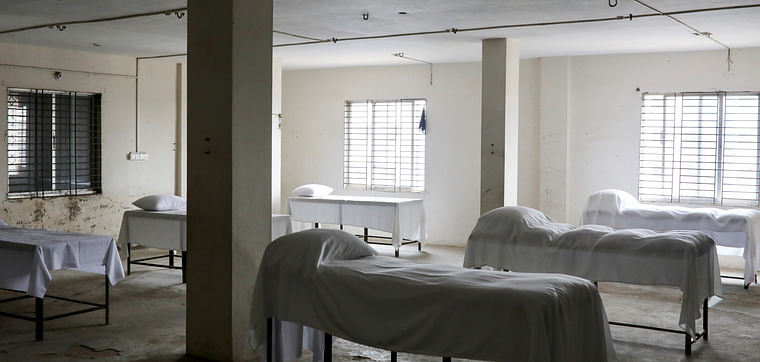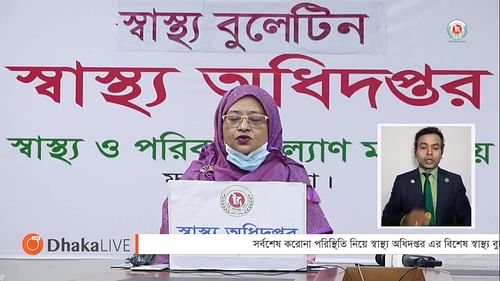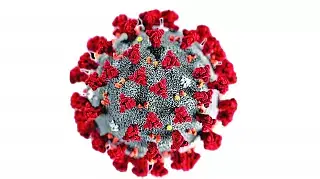
The government has no control over the prevailing pandemic situation in the country. The health directorate is unable to effectively tackle the transmission of coronavirus. Bangladesh is not even fully following the relevant guidelines provided by the World Health Organisation (WHO). No one even has a notion about in which direction the situation heading.
WHO has said that the answers to three questions are vital to tackle the situation. These are: Is the pandemic under control? Is the health system prepared in case the virus transmission increases again? And, do we have the capacity to detect new patients and also carry out contact tracing of those coming into contact with them? Bangladesh lags behind in the answers to all three of these questions, say experts. There is both lack of information and lack of initiative in this regard.
Member of the WHO pandemic preparedness advisory group and former director of the government’s Institute of Epidemiology, Disease Control and Research (IEDCR), Mahmudur Rahman, is endeavouring to find the answers to these questions.
Speaking at a seminar recently, he said that monitoring of the virus transmission must be stepped up. Certain minimum tasks must be carried out to remain safe. However, he declined from commenting separately to Prothom Alo on the matter.
The health ministry, health directorate and affiliated institutions officially began work on the prevention and control of coronavirus from January this year. However, it was only on 1 February when 312 expatriate Bangladeshi and students returned from China and were quarantined at the Hajj camp, that people came to know about the government initiative.
On Friday, the number of confirmed coronavirus cases in the country stood at 3,471, bringing up the total up to over 80,000.
Also Read
Bangladesh coronavirus cases cross China, 44 more die

On Thursday, former director general of the health directorate and member of the 8-member public health advisory committee, Shah Monir Hossain, told Prothom Alo that the pandemic situation in the country was worsening.
From the start of the pandemic outbreak, WHO has been giving its member countries guidelines and advice about the prevention, control and treatment of coronavirus. On 14 April it published an interim guideline regarding public health and social initiatives to deal with the COVID-19 situation. About a month after that, on 12 May, it published an appendix to the guidelines which contained those questions.
Hospitals where COVID-19 cases are being treated do not have adequate monitoring and supervision regarding the quality of treatment. From the very outset there have been complaints about treatment. There are also allegations that non-COVID patients are not receiving treatment at the hospitals
Several countries of the world have managed to bring the coronavirus situation under control. Some countries are on the way. In some countries, no new cases are appearing. But it is different in Bangladesh. The country is failing to take any bold step with confidence.
Three months after the virus has spread, some areas are being placed under experimental lockdown. People have their doubts as to how effective this measure will actually be and how long it will take for the situation to improve.
Also Read
‘We are heading towards an even worse situation’

Director general of the health directorate, Abul Kalam Azad, speaking to Prothom Alo, said that an app had been created for contact testing. He advised Prothom Alo to contact the IEDCR director for further information. Attempts were made to contact the IEDCR director Meerjady Sabrina, but she was unavailable.
Is the pandemic in control in Bangladesh? WHO says that the answer can be found through epidemiological analysis. The pandemic can be said to be under control in any country if, 3 weeks after it peaks, the rate of transmission goes down by 50 per cent. Also, if the rate of infection goes down by 5 per cent in 2 weeks, it can be said that the pandemic is under control. The situation can also be said to be under control if the number of deaths is fewer. It indicates that the infection has lessened due to testing and prevention measures.

Neither the health directorate nor IEDCR has any information about at which stage Bangladesh stands. No one can say when the infection will peak in the country. A researcher involved in COVID-19 testing, on condition of anonymity said, the number of tests is increasing and the rate of infection remains the same. On average 20 per cent of the tests are positive. If the number of tests is doubled and then the rate of infection drops, then one can say the situation is improving.
Also Read
Health sector in dire straits due to inefficiency, mismanagement, corruption

Bangladesh is among the 10 countries where the number of daily confirmed cases is on a rise. Several local and foreign public health experts have said that the actual number of cases is more than the numbers published by the government. Former director of the government’s disease control department, Be-Nazir Ahmed, felt there were many loopholes is the collection of samples, testing and the information on the infected persons.
Hospitals’ preparedness
WHO has said the yardstick of a country’s preparedness is what it is doing about the medical treatment for COVID and non-COVID patients. An important question is whether all COVID patients are being given quality treatment. The other question is whether seriously ill non-COVID patients are getting proper treatment according to the country’s standards. Another question is whether the number of deaths has increased in the hospitals and also whether all the hospitals have coronavirus testing facilities.
The hospitals where COVID cases are being treated do not have adequate monitoring and supervision regarding the quality of treatment. From the very outset, there have been complaints about treatment. There are also allegations that non-COVID patients are not receiving treatment at the hospitals. No one has the information as to whether the death rate has increased. And not all hospitals have coronavirus testing facilities.
There were weaknesses in identifying patients from the very beginning in the country. IEDCR has initially done some contract tracing, but later this responsibility was shifted from IEDCR. No one knows when this task will begin in an effective manner.
So far 81,523 coronavirus cases have been confirmed as of Friday. On Friday, 9,012 coronavirus patients were in hospital and 54,167 were undergoing treatment at home. The health directorate has no effective system to know about the condition of the patients being treated at home.
The government, however, has increased the number of physicians and nurses in order to improve the quality of medical treatment. The process is on for further appointment of health workers.
Public health surveillance
WHO has said that every country must have an adequate number of testing laboratories and specific strategies to detect the infected persons. Effective surveillance and observation is essential to detect the cases. The organisation has recommended that this task be divided into three parts.
Firstly, the detection tests must be conducted in all areas and among all persons at risk. The tests must continue at the community level, at primary healthcare centres, hospitals and influenza monitoring centres. Records must be kept of how many people are dying of coronavirus at hospitals and communities. Records must be kept of how many tests are being carried out daily and how many are being infected.
Also Read
‘COVID-19 cases on an alarming rise’

Secondly, an emergency team must always remain active to identify patients at all levels. And 90 per cent of the suspected patients must be kept in isolation. They must be tested and the results confirmed within 48 hours and placed under treatment or released. If this can be done, it will be possible to reduce the infections.
Thirdly, persons who have come into contact with coronavirus patients must be identified. At least 80 per cent of such persons must be found and kept in quarantine within 72 hours. They must be kept under observation for 14 days at least. A special information management system must be put in place to keep record of the contact testing and other information.
Also Read
When can 30,000 tests be done?

There were weaknesses in identifying patients from the very beginning in the country. IEDCR has initially done some contract tracing, but later this responsibility was shifted from IEDCR. No one knows when this task will begin in an effective manner. The number of labs has increased and till Friday, there are 59 in total where COVID testing is carried out.
Public health expert and member of the health directorate’s public health advisory committee, Abu Jamil Faisal, said that WHO has also said that the entire government machinery should be included in tackling the pandemic to bring it under control. It was not a matter of the health ministry alone.
He said, it will be difficult to bring the pandemic under control unless the local government ministry, the religious affairs ministry, the information and communications ministry and all concerned ministries as well as the general public are included in the effort.
* The report, originally published in the print edition of Prothom Alo, has been rewritten in English by Ayesha Kabir










It hurts us to read such news of incompetency of our country. I hope they get adequate testing materials, adequate people for contact tracing and more people in managing this pandemic outbreak. Our country needs all the support in better organizing and tackling this grim situation.